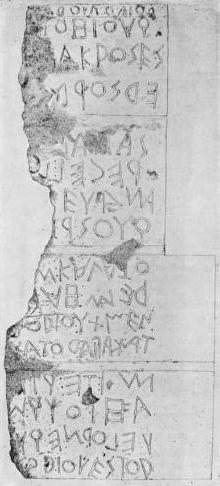Boustrophedon


Boustrophedon (/[invalid input: 'icon']ˌbaʊstr[invalid input: 'ɵ']ˈfiːdən/ or /ˌbuːstroʊˈfiːdən/; from Greek βουστροφηδόν "ox-turning"—that is, turning like oxen in ploughing), is a type of bi-directional text, mostly seen in ancient manuscripts and other inscriptions.[1] Every other line of writing is flipped or reversed, with reversed letters. Rather than going left-to-right as in modern English, or right-to-left as in Hebrew and Arabic, alternate lines in boustrophedon must be read in opposite directions. Also, the individual characters are reversed, or mirrored.
The name "boustrophedon" is taken from the Greek language. Its etymology is from βούς—bous, "ox" + στρέφειν—strephein, "to turn" (cf. strophe), because the hand of the writer goes back and forth like an ox drawing a plough across a field and turning at the end of each row to return in the opposite direction (i.e., "as the ox ploughs"). It was a common way of writing in stone in Ancient Greece.[2]
Explanation
Many ancient scripts, such as Safaitic and Sabaean, were frequently or typically written boustrophedonically, but in Greek it is found most commonly on pre-historic and archaic inscriptions, becoming less and less popular throughout the Hellenistic period.
By analogy, the term may be used in other areas to describe this kind of alternation of motion or writing. For example, it is occasionally used to describe the print head motion of certain dot matrix computer printers. In that case, while the print head moves in opposite directions on alternate lines, the printed text is usually not in boustrophedon format.[3]
Examples in English
Wall text
The wooden boards and other incised artifacts of Rapa Nui also bear a boustrophedonic script called Rongorongo, which remains undeciphered. In Rongorongo the text in alternate lines was rotated 180 degrees rather than mirrored; this is termed reverse boustrophedon.
Tablet text
Example of Hieroglyphic Luwian
The Egyptian language represented with hieroglyph texts and wall reliefs, is the major hieroglyphic language from antiquity; the only other language that also had a hieroglyph version, was the Luwian language and its hieroglyphic Luwian, read boustrophedon;[4] (most of the language was in cuneiform). Other languages that appear to have 'hieroglyphs' are explained as glyphs that make up a language with "script characters" or sets, (with some characters that are virtually identical to varieties of hieroglyphs).
The Hieroglyphic Luwian is read boustrophedon, with the direction of any individual line pointing into the front[meaning ambiguous: obverse to the front or pointing the same way as it?] of the animals or body parts constituting certain hieroglyphs. However, unlike Egyptian hieroglyphs with their numerous ideograms and logograms which show an easy directionality, the lineal direction of the text in hieroglyphic Luwian is harder to see.
Other examples
A modern example of boustrophedonics is the numbering scheme of sections within survey townships in the United States and Canada. In both countries, survey townships are divided into a 6-by-6 grid of 36 sections. In the U.S. Public Land Survey System, Section 1 of a township is in the northeast corner, and the numbering proceeds boustrophedonically until Section 36 is reached in the southeast corner. Canada's Dominion Land Survey also uses boustrophedonic numbering, but starts at the southeast corner.[citation needed]
The term is used by postmen in the United Kingdom to describe street numbering which proceeds serially in one direction then turns back in the other.[citation needed] This is in contrast to the more common method of odd and even numbers on opposite sides of the street.
In art history, it additionally means that you read from bottom left in a series of pictures; as in the stained glass windows at Sainte-Chapelle in Paris.[citation needed]
Another example is the boustrophedon transform, known in mathematics.[5]
Sometimes computer printers with a typewriter-like moving type head print boustrophedon text if set up wrongly.[citation needed]
The IBM 1360 Photo-Digital Storage System records its data boustrophedonically.[citation needed]
Additionally, the writing system of the Ancient Indus Valley, although still undeciphered, can be written boustrophedonically.[6]
In constructed languages
The constructed language Ithkuil uses a boustrophedon script.
The Atlantean language created by Marc Okrand for Disney’s 2001 film Atlantis: The Lost Empire is written in boustrophedon to recreate the feeling of flowing water.
The written language of the Minbari in the television series Babylon 5 is written in boustrophedon. This is evidenced by the episode in which Ambassador Delenn is dictating a formal letter, and the computer dictation writes the alien script starting top-to-bottom and changing from right-to-left or left-to-right for each new line.
See also
- Mirror writing
- Sator square—one interpretation reads it boustrophedon
- Stoichedon
References
- ^ Sampson, Geoffrey (1985). Writing Systems: A Linguistic Introduction. Stanford University Press. p. 103. ISBN 0-8047-1756-7.
- ^ Threatte, Leslie (1980). The grammar of Attic inscriptions. W. de Gruyter. pp. 54–55. ISBN 3-11-007344-7.
- ^ Boustrophedon in the Jargon File of hacker slang
- ^ Campbell, George Frederick (2000). Compendium of the World's Languages. Routledge. p. 78. ISBN 0-415-20296-5.
- ^ Weisstein, Eric W. (2002). CRC Concise Encyclopedia of Mathematics, Second Edition. Chapman & Hall/CRC. p. 273. ISBN 1-58488-347-2.
- ^ Possehl, Gregory. "The Indus Civilization: An Introduction to Environment, Subsistence, and Cultural History (2003)


